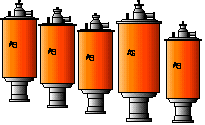
|
SampleEnvironment |
|

SINQ LIN LIN
SINQ Wiki
This Page
Referenced by
Wiki Info
JSPWiki v2.0.52
|
|
This is version 15.
It is not the current version, and thus it cannot be edited. Sample environment at SINQ
StaffStephan Fischer, Walter Latscha (technicians)Markus Zolliker (software) Ben van den Brandt (group leader "Sample Environment and Polarized Targets")
EquipmentThe broad range of research topics investigated at SINQ requires not only a large zoo of neutron scattering instruments but also a large collection of sample environment devices. At present, any temperature between 100 mK to 1400 K, any magnetic fields up to 9 T and any high pressure up to 30 kbar may be achieved. The PSI-Risų collaboration helped to complete the sample environment park in the direction to higher magnetic fields and very low temperatures for single crystals. collaboration helped to complete the sample environment park in the direction to higher magnetic fields and very low temperatures for single crystals.
For details see the table with specific information about sample environment devices
Closed Cycle RefrigeratorsFor temperatures between 4 K and 325 K, in general, closed cycle refrigerators are the best choice, as they are very easy to use. Our closed cycle refrigerators are mostly from CTI-Cryogenics , and from
APD Cryogenics , and from
APD Cryogenics .
The 4 K closed cycle machines are from
Sumitomo Heavy Industries .
The 4 K closed cycle machines are from
Sumitomo Heavy Industries .
The accuray of the temperature in a closed cycle machine (cold finger principle) is limited. See
Test Report .
The accuray of the temperature in a closed cycle machine (cold finger principle) is limited. See
Test Report on a CTI. on a CTI.
Helium CryostatsFor temperature down to 1.5 K, or if a precise temperature is required, helium cryostats should be used. The working horse is the ILL Orange cryostat, manufactured at AS Scientific Products Ltd . .
Dilution CryostatsDilution cryostats are used for very low temperatures down to millikelvin temperatures.
FurnacesActually, three furnaces are available covering the temperature range between RT and 1800 K. Two are constructed at the PSI. A third device was manufactured at the ILL (now available for AS Scintific). Please contact the sample environment group before any experiment with a furnace, as different aspects have to be discussed in advance.
MagnetsSupraconducting magnets are used to achieve magnetics fields up to 15 Tesla. The old 4 Tesla Magnet manufactured by Thor is limited in the temperature range, but has less stray fields and is therefore preferred on instruments with a magnetic environment. The Oxford Instruments Cryomagnets MA02 and MA09 from Risų may be used with sample temperatures from 300 K down to 0.1 K when combined with the dilution stick. For details see Magnet List. Cryomagnets MA02 and MA09 from Risų may be used with sample temperatures from 300 K down to 0.1 K when combined with the dilution stick. For details see Magnet List.
Pressure DevicesThe clamp cell pressure devices are manufactured at the Institute for High Pressure Physics (RAS Moscow). Pressures up to 30 kbar (3 GPa) may be achieved.
The temperature devices are controlled with the TECS software. A quick online-help
|

